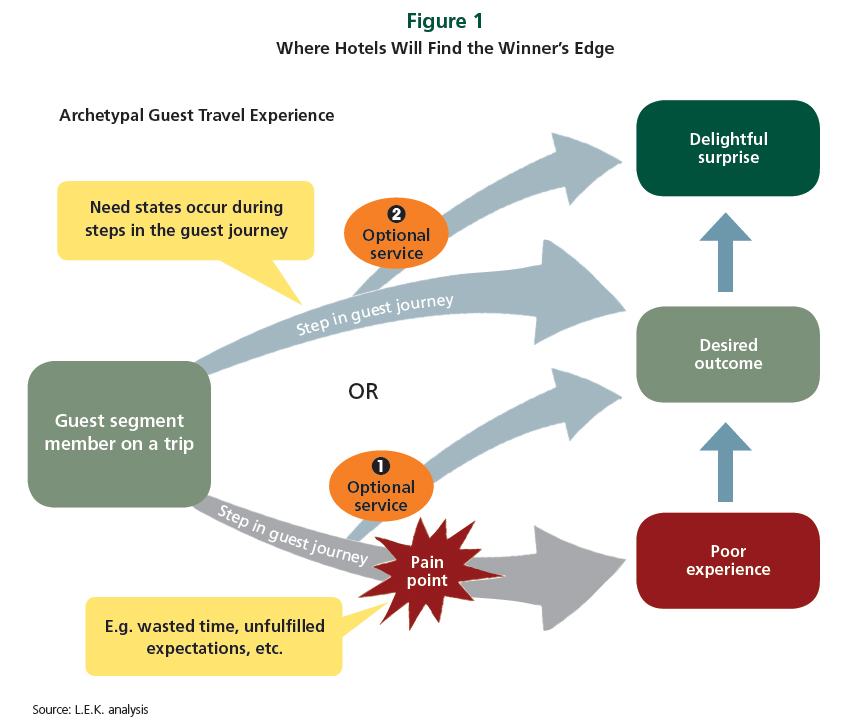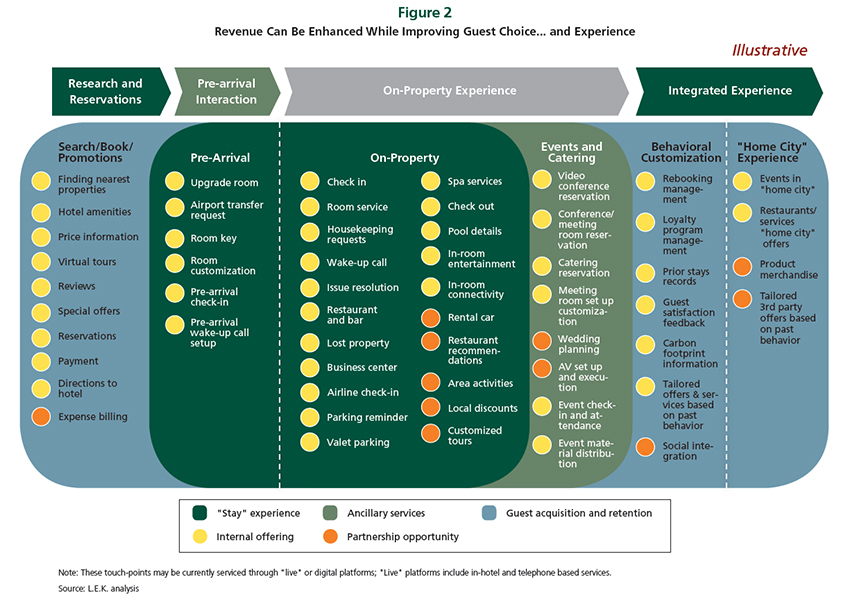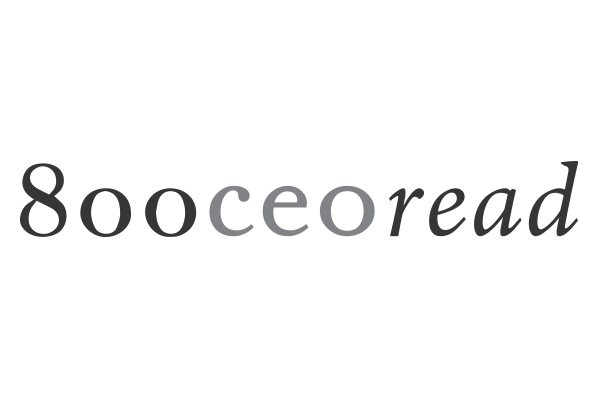By Alan Lewis and Dan McKone
The following article was first published as L.E.K. Consulting Executive Insights’ Volume XV, Issue 20 on August 29, 2013.
In a lower-growth environment, many companies look beyond their core business. But in scanning the horizon for new markets and new products, companies often overlook an enormous, untapped source of profit that exists in the near-field – on the edge of the core business through the sale of ancillary goods and services that actually make a customer’s interaction with the core business more complete. By adopting an Edge Strategy™ mindset, you can exploit this source of profitable growth.
In this article, L.E.K. Consulting Managing Directors Alan Lewis and Dan McKone show how hospitality companies can apply this strategy through personalized offerings and the sale of ancillary services to hotel guests.
Hotels today are missing a trick. Somewhere along the way, their guests’ expectations changed, and hotels have been slow to react. Personalization and customization have revolutionized other corners of the travel industry, reconditioning guests to expect options and to demand choice — and allowing companies to sell hugely profitable “edge” offerings to meet these new demands. Travelers can now customize their airline journey by purchasing additional legroom at premium economy prices, buy tapas on board the aircraft or have their bags shipped directly to their destination. They can customize the airport experience by paying to accelerate through the queue or purchase a pass to an airport lounge. They can choose whether they want navigation in their rental car; they can select their specific vehicle (or upgrade) and, increasingly, they can decide whether they want to pick up or drop off that vehicle at an odd location on a city street. In most cases, they can make these choices on the go through their tablets and smartphones.
Most hotels, on the other hand, still offer limited choices for customers: defined check-in and check-out times, limited room selection and a set of very basic “extras” — such as minibar offerings and on-demand movies — that haven’t changed in years. Instead of pursuing an Edge Strategy mindset, property owners in the industry have focused on their core activities of identifying underserved locations, selecting undervalued real estate, building out attractive facilities and striking deals with management and distribution partners. Similarly, these partners — the hotel “flags” — have focused on their own competencies of defining and meeting cohesive brand standards, devising powerful marketing messages and improving the systems (computer reservations, loyalty programs, etc.) that drive customers into their network. The traditional way to make money in the hotel industry has been to make a big bet on property and then ruthlessly manage to a set of disciplined standards while not overpaying for distribution. There has been very little tolerance for anything that adds operational complexity — such as guest options and other Edge Strategy plays.
However, there is enormous profit potential for companies that are innovative enough to add a selective amount of complexity — as players in adjacent industries have shown. The difference between profit and loss for many airlines today is simply their recent introduction of extras and options. JetBlue, for example, generates over $100 million per year by packaging extra legroom with other perks like early boarding and expedited security. Travelers are willing to pay up for convenience, comfort or peace-of-mind, and customer satisfaction actually improves in the process. Hertz doesn’t need to sell many customers on the convenience of pre-purchasing a tank of gas at a premium to realize handsome returns. Edge offerings require relatively straightforward presentation, can sometimes cost very little to deliver and they can create value for a select segment of customers who purchase them.
Ironically, the work hotels have undertaken to foster their core business is what now enables them to branch out and discover lucrative ancillary offerings. Only by executing well in your core will customers give you permission to play at the edge. For hotels, the edge is best defined as any attribute along the guest journey that can be “flexed” up or down to create a differential experience. Some guests are primarily interested in value, so why make them subsidize features and benefits they don’t want? Some guests are frustrated that the base offer leaves them wanting — why deny them? From booking through to checkout and beyond, guests experience a variety of activities, touch-points and decision opportunities that could be exploited to create either a basic option or an attractive customer choice at a premium. The goal for the hotel should be to predict each “pain point” during the customer’s journey and provide a delightful solution; by mapping the journey, hotels can identify these opportunities (see Figure 1 below). Instead of facing a uniform tier of service through their entire stay that is defined by a rough price point (e.g., luxury, midscale, etc.), customers can choose to buy up or opt out of extra goods and services at each interaction with the hotel, in a truly customizable manner.

Meals-to-go, enhanced shower heads, luxury linens and pillows, late checkouts, concierge treatment, and room selection are only a few of many offerings hotels could sell to their customers (see Figure 2 below). Many of these items tend to be extremely high margin when properly merchandised and sold. Once customers have made the basic decision of which hotel to go with (based, in part, on budget) they often relax their minds and wallets and are susceptible to additions that can seem trivial compared to the cost of the overall stay. But these add-ons add up. In some cases, such as a late checkout product, the incremental revenue can be captured by assigning a monetary value, and discipline, to activities that happen sporadically today.

Building options to layer on to the base proposition also provides a quick and effective means to sharpen a hotel’s brand and gain customer loyalty. When hotels compete solely within price tiers it suppresses differentiation and promotes price competition, all the while commoditizing the offering in the mind of the consumer. Creating options is also lower risk; it provides a more flexible approach than, say, expending significant capital to renew and refresh a property where ADR growth has slowed. As the hospitality industry evolves, we will see much more targeting from brands seeking to address the needs of guest segments at different points along the customer journey. This approach is extremely familiar in the consumer-products world; Cadbury or P&G would certainly never consider a strategy that didn’t contemplate need states and day parts more formally. But in the hotel space it is still a relatively nascent concept where few material actions have been taken. When it is applied — to date, most effectively by boutique hotels — it can build meaningful differentiation. Well-designed customer experiences, laden with edge offerings, are hard to copy.
Once a company commits to this strategy, the next step is to make it easy for consumers to buy into solutions targeted at them. This can be achieved by packaging multiple options together. Very much in the way that the auto industry sells a sports package or cold-weather package as a means of encouraging a buyer to purchase multiple extras, the hotel industry can offer bundles in a way that resonates with individual segments. For example, a traveling executive might worry about health and nutrition while on the road; the hotel could offer a nutritious on-the-go option that provides various pre-packaged meals, branded athletic gear on loan for their stay, and local gym passes near the executive’s work site. Or a tourist in town for a sports event could be offered a package that includes a customized tour of local historical sporting sites as well as local sports merchandise placed in his or her room prior to arrival. Such packages create extra profit for their property owners while creating greater loyalty, and valuable repeat business.
Hotels are one of the few sectors of the travel industry that aren’t directly involved in the transit of customers. But that doesn’t mean that their business plans should remain static. Today’s consumers are becoming accustomed to personalization and ancillary offerings. Banks, telecoms, retailers and recently airlines have built successful business models around tiered services that redefine what is included in the base purchase and what then can be layered carefully around the edges of the purchase for high-margin upsell. Hotels can find new ways to reach guests that are much more targeted at how they view themselves, what they want at key points of their journey and how the broader travel industry has conditioned them to expect solutions. Hotels with the vision to configure their offers in this way, and the courage to move first, will capture a winning edge.




